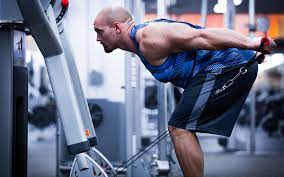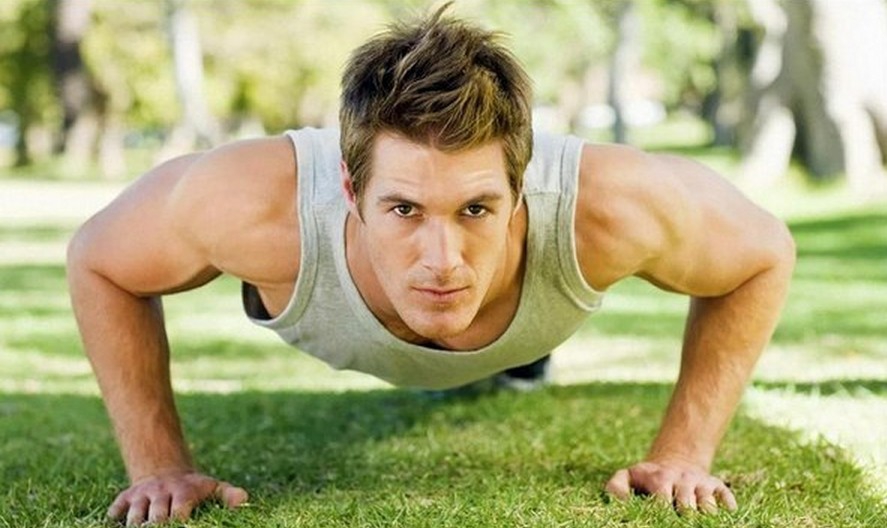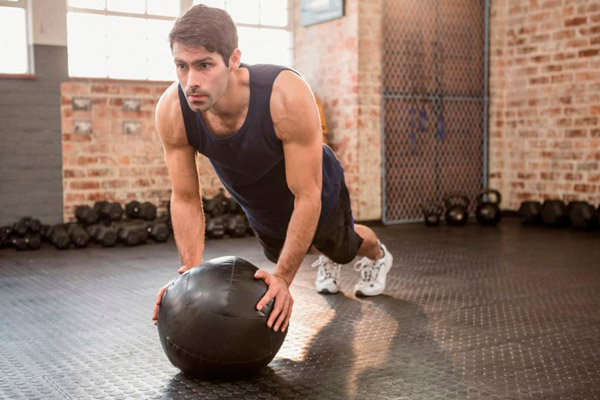The captain’s chair leg raise is the second most effective move for the rectus abdominis as well as the obliques. You can do a variety of exercises on the captain’s chair, which is a rack with padded arms that allows your legs to hang free and can be found in most health clubs and gyms.
The key to keeping this move safe and effective is, first, to avoid swinging the legs or using momentum to bring the legs up. Second, keeping the knees bent will help you focus more on the abdominals and less on the hip flexors.
How to:
Stand on the chair and grip handholds to stabilize your upper body.
Press your back against the pad and contract the abs to raise the legs and lift kneestowards your chest.
Press your back against the pad and contract the abs to raise the legs and lift kneestowards your chest.
Don’t arch the back or swing the legs up.
Slowly lower back down and repeat for 1-3 sets of 12-16 reps.
If you don’t have access to a captain’s chair rack, you can try a ball roll out as a substitute.
Slowly lower back down and repeat for 1-3 sets of 12-16 reps.
If you don’t have access to a captain’s chair rack, you can try a ball roll out as a substitute.

Place an exercise ball nearby and lay on the floor in front of it with your hands on the floor shoulder width apart in a push-up position.
Now place your lower shins on top of an exercise ball. Tip: At this point your legs should be fully extended with the shins on top of the ball and the upper body should be in a push-up type of position being supported by your two extended arms in front of you. This will be your starting position.
While keeping your back completely straight and the upper body stationary, pull your knees in towards your chest as you exhale, allowing the ball to roll forward under your ankles. Squeeze your abs and hold that position for a second.
Now slowly straighten your legs, rolling the ball back to the starting position as you inhale.
Repeat for the recommended amount of repetitions
Repeat for the recommended amount of repetitions

Lie flat on your back and bend your knees about 60 degrees.
Keep your feet flat on the floor and place your hands loosely behind your head. This will be your starting position.
Now curl up and bring your right elbow and shoulder across your body while bring your left knee in toward your left shoulder at the same time. Reach with your elbow and try to touch your knee.
Exhale as you perform this movement. Tip: Try to bring your shoulder up towards your knee rather than just your elbow and remember that the key is to contract the abs as you perform the movement; not just to move the elbow.
Now go back down to the starting position as you inhale and repeat with the left elbow and the right knee.
Continue alternating in this manner until all prescribed repetitions are done.
Variation: You can also do all of your repetitions for one side and then switch to the other side.
Variation: You can also do all of your repetitions for one side and then switch to the other side.

Lie on an exercise ball with your lower back curvature pressed against the spherical surface of the ball. Your feet should be bent at the knee and pressed firmly against the floor. The upper torso should be hanging off the top of the ball. The arms should either be kept alongside the body or crossed on top of your chest as these positions avoid neck strains (as opposed to the hands behind the back of the head position).
Lower your torso into a stretch position keeping the neck stationary at all times. This will be your starting position.
With the hips stationary, flex the waist by contracting the abdominals and curl the shoulders and trunk upward until you feel a nice contraction on your abdominals. The arms should simply slide up the side of your legs if you have them at the side or just stay on top of your chest if you have them crossed. The lower back should always stay in contact with the ball. Exhale as you perform this movement and hold the contraction for a second.
As you inhale, go back to the starting position..
Repeat for the recommended amount of repetitions.
Caution: Perform this exercise slowly and deliberately as it takes some getting used to. Also, do not be hasty and try to useweights on the first time; you’ll have enough on your hands learning how to balance yourself.
Caution: Perform this exercise slowly and deliberately as it takes some getting used to. Also, do not be hasty and try to useweights on the first time; you’ll have enough on your hands learning how to balance yourself.

Also, if balance is an issue I recommend having a spotter next to you and also placing each of your feet under a 100-lb dumbbell for added stability. As you get more advanced you can hold a dumbbell or a weight plate (held at arm’s length) on top of your chest. However, you have tobe very careful when adding weight to this exercise, because if you add too much too quickly you could get a hernia.
Variations: You can perform this exercise with a low pulley behind you with a rope attached on its end. In this manner you can go ahead and add resistance easier. For this variation, you will need to hold on to the sides of the rope throughout the movement. I like to bring my arms forward to the point that the upper arms are almost parallel to my torso and the lower arms are facing back holding the rope.
